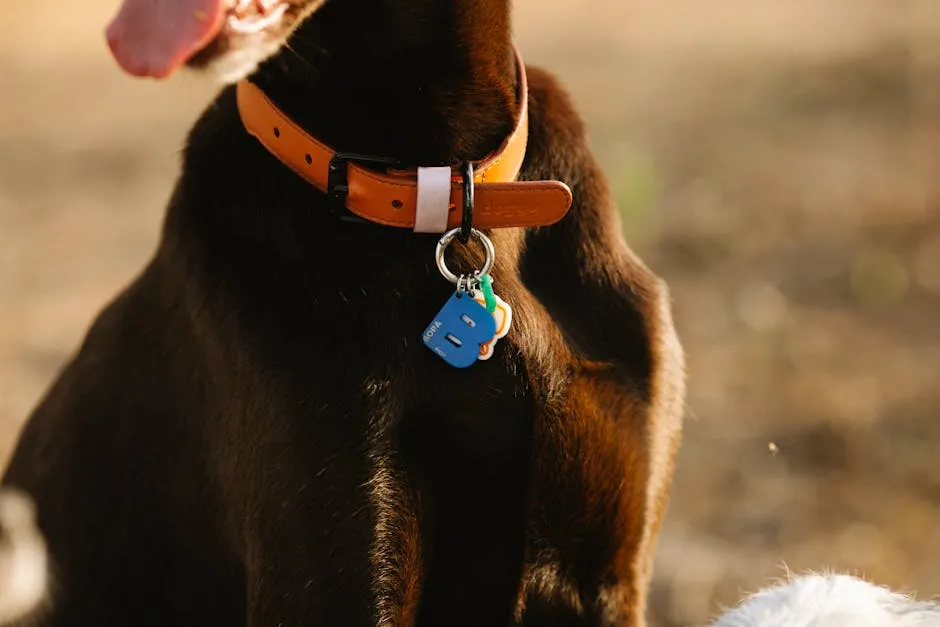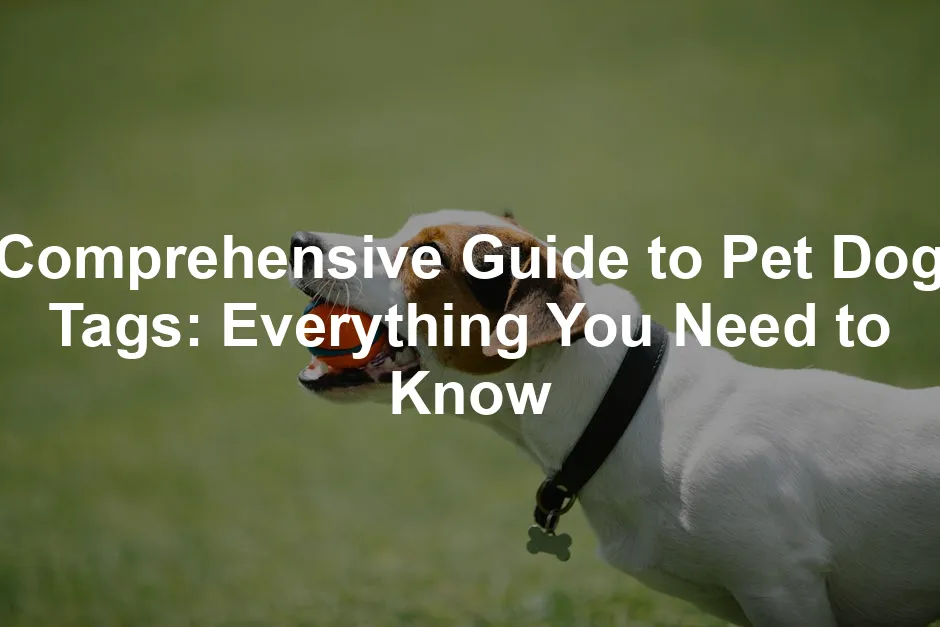Introduction
Have you ever wondered how to keep your furry friend safe? Pet dog tags are essential for this reason. They not only help identify your dog but also provide peace of mind. You can find a wide variety of styles, materials, and customization options. This article aims to give you a thorough understanding of pet dog tags, their benefits, and tips on choosing the perfect one.
Speaking of keeping your furry friend safe, why not consider a Dog GPS Tracker? It can give you peace of mind knowing exactly where your pup is at all times. Just think of it as a life jacket for your dog’s adventures—keeping them safe while they explore!
Summary and Overview
Pet dog tags are small identification tags attached to your dog’s collar. Their primary function is to help identify lost pets. Typically, these tags include crucial information like the pet’s name and the owner’s contact details. Having a dog tag is vital for your pet’s safety, as it increases the chances of a quick reunion if they get lost. Lately, personalized and decorative dog tags have gained popularity, allowing owners to express their pet’s unique personality while ensuring they remain identifiable.

And while you’re at it, consider getting a Custom Pet Dog Tag! It’s a simple way to add a personal flair while ensuring your dog has a unique identifier.
The Importance of Pet Dog Tags
Why Every Dog Needs a Tag
Dog tags play a crucial role in reuniting lost pets with their owners. Statistics show that millions of pets go missing each year. In fact, a significant number of pets are returned to their families thanks to identification tags. A simple tag can make all the difference in helping your furry friend find their way home.
To further enhance your pet’s safety, consider investing in a Dog Training Clicker. This tool can help you train your dog effectively, making sure they listen to you even when they’re excitedly chasing after a squirrel!
Legal Requirements for Dog Tags
In many areas, having a dog tag is more than just a good idea; it’s often a legal requirement. Laws vary by region, but many places require pets to wear identification tags. Not having a tag can lead to fines or other penalties. Moreover, failing to comply with these regulations puts your pet at risk of being lost without a way to identify them.

Types of Pet Dog Tags
Material Options
When it comes to pet dog tags, the material matters. Here are some common options:
Stainless Steel: This is a popular choice. It’s durable and resistant to rust. Stainless steel tags can withstand the elements. However, they can be heavier compared to other materials.
Aluminum: Lightweight and affordable, aluminum tags are great for smaller pets. They come in various colors. On the downside, they can scratch easily and may not be as long-lasting.
Brass: Known for its classic look, brass is sturdy and can develop a unique patina over time. It’s heavier than aluminum but more durable. However, it may tarnish if not cared for properly.
Silicone: This newer option is flexible and quiet. Silicone tags are available in many colors and shapes. While they are lightweight, they may not be as durable as metal tags.
Choosing the right material depends on your dog’s size, lifestyle, and your budget. Consider these pros and cons to find the perfect fit.

Styles and Shapes
Dog tags come in various shapes and styles, adding a personal touch. Popular shapes include:
Bone: This classic shape is instantly recognizable and loved by many dog owners.
Circle: A simple yet elegant option, circles are versatile and easy to read.
Heart: Perfect for pets who are truly loved, heart-shaped tags can showcase affection.
Custom Shapes: Want something unique? Some brands offer themed tags based on dog breeds or hobbies. You can customize them with your pet’s name, favorite colors, or fun designs.
Personalization doesn’t stop at shapes. Many manufacturers allow you to add your dog’s name, your contact information, or even fun graphics. This customization ensures your pup’s tag stands out while being functional.

Customizing Your Dog Tag
Personalization Options
Personalizing your dog tag is a fantastic way to enhance its functionality. Engraving options can include:
- Name: Clearly displaying your pet’s name helps in identification.
- Phone Number: Including your phone number increases the chances of a quick reunion.
- Address: Some owners opt to add their home address for extra security.
- Medical Information: Tags can also display medical alerts, essential for dogs with specific health needs.
Having this additional information can be a lifesaver. Tags with medical alerts can inform finders about your dog’s needs. And speaking of needs, don’t forget to stock up on a Pet First Aid Kit for those unexpected moments. It’s better to be prepared than to panic!

Design and Aesthetic Choices
The design of your dog’s tag matters too. You can choose from a wide variety of colors, patterns, and shapes. Some options include:
- Bright Colors: Vibrant colors can make the tag more visible.
- Fun Patterns: From polka dots to floral designs, patterns can reflect your dog’s personality.
- Unique Shapes: Choosing a distinctive shape can make your pet’s tag stand out.
Selecting a tag that matches your dog’s personality or your style adds a personal touch. This small detail can make your pet feel even more special. And if you want to make your dog feel even more pampered, consider a Dog Bed with Removable Cover. It’s like a cloud for your four-legged friend!

Best Practices for Choosing a Dog Tag
Size Matters
Choosing the right size tag is crucial. A tag that’s too large can be uncomfortable for small breeds. Conversely, a tiny tag may be hard to read on larger dogs. For small breeds, opt for tags around 1 inch in diameter. Medium breeds do well with tags about 1.5 inches, while large breeds can handle 2-inch tags. Always consider your dog’s comfort and make sure the tag fits well.

Visibility and Readability
When selecting a dog tag, prioritize visibility. Clear fonts make a huge difference. Opt for tags with bold lettering to ensure the information is easy to read. Avoid overly decorative fonts; they can be difficult to decipher. Remember, the main purpose of the tag is identification. If finders can’t read the information quickly, it defeats the purpose. Choose colors with high contrast to make details stand out.

Attachment Methods
How you attach the tag matters just as much as the tag itself. There are several methods to consider. Split rings are the most common, providing a secure way to attach the tag to the collar. Clips offer a quick-release option, which is handy for activities like swimming. Rivets are another choice, permanently fixed to the collar, eliminating the risk of loss. Make sure whichever method you choose keeps the tag secure, preventing it from falling off during playtime or walks.

Where to Buy Pet Dog Tags
Online Retailers
Shopping for pet dog tags online offers convenience and variety. Popular online stores like Amazon, Chewy, and Petco have extensive selections. Many of these retailers allow customization options, so you can create a unique tag for your dog. You can choose from various designs, materials, and engraving options. Shopping online also often means you can read reviews and compare prices effortlessly. By the way, if you’re looking for a cool way to carry your pet’s essentials, check out the Dog Backpack for Hiking. Your dog can carry their own snacks and toys while you enjoy the great outdoors!

Local Pet Stores
Buying from local pet stores has its perks. You can see the tags in person, ensuring quality and size before purchasing. Immediate availability means no waiting for shipping. Plus, when you shop locally, you support your community. Many local stores also offer customization services on-site, allowing you to personalize the tag right away. It’s a great way to ensure your furry friend has a stylish and functional identification tag quickly.

Maintenance and Care of Dog Tags
Keeping Tags Clean
Maintaining your dog’s tag is essential for its longevity and appearance. For metal tags, regular cleaning prevents tarnishing. Use a soft cloth to wipe the surface. If the tag is particularly dirty, warm water and mild dish soap work wonders. Gently scrub with a toothbrush, especially around engraved areas. Rinse it off and dry thoroughly to prevent water spots. Avoid harsh chemicals, as they can damage the finish. For silicone tags, simply rinse with water and air dry. Keeping your pet’s tag clean ensures it remains visible and readable. Speaking of cleanliness, investing in Pet Cleaning Wipes can make your life a whole lot easier after those muddy outdoor adventures!

Regular Updates
Updating your dog’s tag is crucial. If your contact information changes, make sure to update the tag immediately. An outdated phone number can delay a reunion if your dog gets lost. Additionally, consider adding medical information if your pet has specific needs. Tags can indicate allergies or conditions, alerting finders to your dog’s care requirements. Regularly check the tag for legibility, replacing it if it shows wear or fading. Keeping information current helps keep your pet safe and sound.

Conclusion
Pet dog tags are vital for ensuring your dog’s safety. They provide quick identification and peace of mind for owners. When choosing a tag, consider one that reflects your pet’s personality while also fulfilling its main purpose. Take a moment to check your pet’s tag today. You might find it’s time for an upgrade or some personalization! And while you’re at it, treat your pup to a Dog Treats Variety Pack—because who doesn’t love a good treat?

FAQs
What should I put on my dog’s tag?
When creating your pet dog tag, include essential information. Start with your dog’s name. This helps identify them quickly. Next, add your contact information, like a phone number. If possible, include your address for extra safety. Adding medical information can also be helpful, especially for dogs with health conditions. This ensures finders know how to assist your pet if needed.
Are there any legal requirements for dog tags?
Yes, many regions have laws about pet identification. These laws can vary significantly, so it’s wise to check local regulations. For example, some areas require dogs to wear tags at all times. Not having a tag can lead to fines or other penalties. Compliance with these laws helps protect your pet and increases the chance of a happy reunion if they go missing.
How do I choose the right size for a dog tag?
Choosing the correct size is crucial for comfort and visibility. Start by considering your dog’s breed. For small breeds, tags around 1 inch are ideal. Medium breeds typically fit well with 1.5-inch tags. Larger dogs can handle tags that are 2 inches in diameter. Always ensure the tag is readable and does not overwhelm your pet’s collar.
Can I get a dog tag with a design or theme?
Absolutely! Custom dog tags come in various designs and themes. You can choose from shapes like bones, hearts, or circles. Additionally, some retailers offer designs based on popular culture or specific dog breeds. Personalizing a tag with your dog’s favorite colors or patterns is a fun way to make it unique.
How do I maintain my pet’s dog tag?
Keeping your dog tag clean is important for readability. For metal tags, use a soft cloth to wipe away dirt. If it’s really grimy, warm water and mild soap will do the trick. Rinse it well and dry thoroughly. Silicone tags can be rinsed under water and air-dried. Regular cleaning helps maintain the tag’s appearance and functionality.
What materials are best for dog tags?
The choice of material is essential for durability. Stainless steel is popular for its strength and resistance to rust. Aluminum tags are lighter and often more colorful, though they can scratch easily. Brass offers a classic look but may tarnish without proper care. Silicone tags are flexible and quiet but might not last as long as metal ones. Choose based on your dog’s needs and your budget.
Where can I purchase dog tags?
You have plenty of options for buying dog tags. Online retailers like Amazon and Chewy offer a wide selection of custom dog tags. Many local pet stores also stock tags and may provide customization services. Shopping locally lets you see the tag before purchasing. No matter your choice, ensure you find a tag that meets your needs.
Please let us know what you think about our content by leaving a comment down below!
Thank you for reading till here 🙂
All images from Pexels





